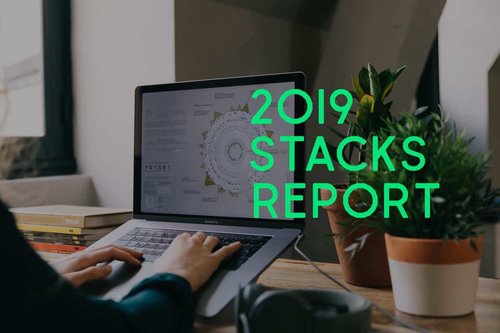Want to Build a Great Tech Company Blog?
Mar 05, 2019
6 mins


Software engineer, writer, and educator on a mission to watch the world learn
Blogs are a popular way for companies to communicate with customers, potential clients, and the world at large. A great blog can help current customers connect with your brand, or provide a source of critical documentation for your product or service. For potential customers it can serve as a sample of what your company provides. For the world at large it’s a chance to boost brand awareness.
A blog can also serve as an internal communication system—posts give employees the chance to read about what’s happening in other parts of the company and keep up to date on products and happenings that they might otherwise miss. Similarly, they can give potential employees an idea of the kinds of problems they’ll get to work on if they come to work for you, as well as establish your firm as an authority in your domain.
Company blogs also offer career-development opportunities to the employees who participate. A great write-up of a new feature or interesting development in their area of expertise can serve as an impressive portfolio piece for the author. Evangelizing about an employee’s post internally is also a chance to show them that their work is appreciated and help them feel recognized.
But not every blog is created equal. A great one can produce great benefits, but a crummy blog won’t. Here are some things you can do to make yours more compelling for current and prospective clients and employees.
Set realistic goals before starting
Creating a great blog will require assigning significant resources to the task. Before you make that commitment you need to consider what you want to get out of the blog—and what you can get out of it. If your goal is to go viral and get millions of page views in a short period of time, stop now. While you might get lucky and write something that takes the internet by storm, it’s not likely.
It is a good idea to set a traffic goal and track your blog’s performance, but it’s also important to set some big-picture goals about what kind of value you want your blog to generate beyond page views. Maybe you want it to serve as documentation for your service and answer common questions or address common complaints. Maybe you want it to showcase your firm’s unique expertise in its field. Or maybe you want it to help employees better understand the work done in different departments.
Regardless of what your goals are, your blog should have a purpose that is bigger than “marketing.” If your posts are just an excuse to do some advertising, your blog won’t attract a lot of readers, because it won’t deliver any value to them. Identify your audience and focus on writing posts that are worth reading.
Commit to good writing
A couple of typos on your résumé can end up disqualifying you from consideration, and it’s the same with a blog. There is an endless stream of reading material online, and modern audiences will not slog through a post that has several errors in the first few paragraphs. No matter how incredible the information in a post is, if it is poorly written, it won’t be read. You should establish an editorial process so that writers can get feedback and to ensure you don’t publish sloppy writing full of spelling and grammatical mistakes.
You should appoint an editor to manage the blog—depending on how often you want to publish, this could very well be a full-time job. Your editor should identify which employees want to write for the blog, schedule the release of new content, and help writers explore and validate ideas for new articles. Once an idea has been selected, the writer and the editor should work together on the piece.
A typical editorial process has 4 stages:
- Rewrite/revision: Big changes to the content and structure of the article. At this stage, whole paragraphs may need to be moved or deleted and new ones added. This is about getting the story right and in the right order.
- Line/stylistic edits: Content-focused changes to individual paragraphs and sentences. At this stage, editors are looking at word choice and sentence structure. This is all about taking the properly structured story and making it delightful to read.
- Copy editing: Style- and grammar-focused changes to individual sentences. At this point, editors are looking for grammatical errors, typos, and inconsistent word choices. This is about making sure each sentence is correct and conforms with your style guide.
- Proofreading: Extremely detail-oriented changes focused on typos and punctuation errors, typically done with the content’s final published format in mind. This is the last chance to catch any lingering mistakes.
The lines between these stages can be blurred and — for shorter content such as blog posts — it’s common to combine stages, especially 2-4. Whether or not you mix your copy editing with your proofreading, you should expect an article to go through 3-4 drafts before being published.
Remember, having a top-quality blog requires resources. Writing and editing will mean agreeing on a trade-off concerning your employees’ other responsibilities. If you can’t spare the time and energy to follow editorial best practices you shouldn’t start a company blog, because no one will want to read it.
Speaking of readers, another aspect of your editor’s job will be to solicit and respond to feedback from them. Remember, ultimately, your readers are the customer of your blog. Take the time to find out what they love—and don’t love—about it, and then adjust your content accordingly.
Write what no one else can
Your company provides a unique service to the world. You’ve collected unique data, encountered unique problems, and created unique solutions. The most interesting company blogs don’t just write about how they chose a web framework—because every web company could write about web frameworks. The blog published by the dating service OkCupid is a fantastic example of how to make the most of your competitive edge. The company collects data on how its users interact, who they message, and who they go on dates with, then analyzes it and presents it in blog posts that examine subjects like racial bias in dating and the kind of lies people tell most often on their platform.
Cloudflare is another organization that successfully leverages its employees’ expertise, as well as its unique position in the networking industry. They write helpful, detailed articles about state-of-the-art networking topics such as HTTP/3 and high-profile hacks against important network infrastructure.
Write helpful content
Other great blogs don’t seek to be just entertaining or generally interesting—they help their readers learn. The engineering blog by the consulting firm Toptal employs this strategy perfectly. Fitting into its business model beautifully, Toptal’s blog is full of software tutorials and how-to guides, often quite advanced ones. The content is derived from problems that its consultants solved for clients. Therefore, the blog not only helps developers solve these problems themselves, but it serves as proof of its consulting team’s expertise. Toptal wants a developer reading one of its blog posts to think, “Maybe I should just hire this person to solve my problem!”
This blog also serves as a great advertisement for people who might want to work at the company—high-quality tutorials signal that your potential coworkers are good communicators and real experts, and that the scope of problems you might solve with Toptal is tantalizingly broad.
Document your challenges and highlight your successes
A company blog is a great place for postmortems. Etsy’s Code as Craft blog is an exemplar of writing about experiments, mistakes, and the lessons learnt along the way. It frequently describes decisions made by engineering managers and teams, and how they worked out. Whether it’s about changing the way A/B tests work or planning for server capacity, the Code as Craft blog thoughtfully documents the impact of those decisions. You can also write about great ideas that were successfully implemented, or changes that had unexpectedly significant ramifications.
This type of content is incredibly useful to managers, executives, and engineers in similar businesses or tackling similar problems. Highlighting your successes also serves as a branding opportunity. Suppose you implemented a feature that dramatically improved customer satisfaction and you have some metrics that prove it—writing about it lets prospective customers know that you think about customer satisfaction and what they can expect if they start using your product or service.
Etsy’s blog also helps its employees better understand what’s happening in other parts of the business and—like Toptal’s—sends a strong signal to potential employees that, at Etsy, you’ll be surrounded by thoughtful, skilled peers who take their work seriously.
Make it beautiful and enticing
Once you’ve got an article full of wonderful advice that delivers real value to your prospective readers, you still have to get them to pick your article out of an ocean of other content. Enlist someone from your design team to create custom illustrations, or allocate some budget for high-quality stock photos. Spend some time thinking carefully about titles for your post. Most people make the decision to click on an article based on a thumbnail and its headline—you only get one chance to make a first impression, so choose your image and headline thoughtfully.
If you’re publishing content on your own website, you should also spend some time getting the style right. Consider common concerns, such as the space between paragraphs, font size, and line height. Additionally, you’ll want to account for different formatting issues, such as block quotes, pull quotes, and code blocks. If you don’t want to invest time in doing this until you know it’s worthwhile, you might consider starting your blog on a publishing website like Medium and port the content to your own website after you’ve validated the idea of maintaining a blog.
In the end, there are many different strategies for building a great company blog, but the best ones have a lot in common. Specifically, they:
- Serve a purpose beyond just being a marketing tool.
- Are well written and have high editorial standards.
- Share unique insights or perspectives.
- Create value for the reader, typically in the form of entertainment or education.
- Are beautiful and draw the reader in with great content and style.
This article is part of Behind the Code, the media for developers, by developers. Discover more articles and videos by visiting Behind the Code!
Want to contribute? Get published!
Follow us on Twitter to stay tuned!
Illustration by Brice Marchal

More inspiration: Career hacking
Because being a developer is not just about coding, we want to share dedicated tips on soft skills and career paths, help you stay up-to-date with your favorite technologies, and learn more about the job market.

Computing’s Gender Divide: Why Tech Is Stuck in the 1980s
Discover why the percentage of women who held computing-based jobs has been in a steady decline since the 1980s.
Sep 14, 2020

5 Remote-work Lessons From the Open-source Community
The open-source movement has a few things it can share about remote working with the wider software-development community.
Jun 09, 2020

2019 Stacks Report
The most-mentioned technologies in the job specifications published on WTTJ's website in 2019 and the average number of applicants per technology.
Apr 21, 2020

Engineering Management: An Interview with Saad Rehmani
Saad Rehmani, the VP of Engineering at Reddit, shares his most effective management strategies to handle the COVID-19 crisis.
Apr 07, 2020

Engineering Management: An Interview with Rich Archbold
Rich Archbold, the VP of Engineering at Intercom, explains how to develop a management style and how to transition to managing other managers.
Mar 17, 2020
The newsletter that does the job
Want to keep up with the latest articles? Twice a week you can receive stories, jobs, and tips in your inbox.

Looking for your next job?
Over 200,000 people have found a job with Welcome to the Jungle.
Explore jobs